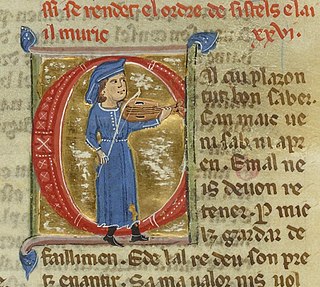Related Research Articles

Prince of Orange is a title associated with the sovereign Principality of Orange, in what is now southern France and subsequently held by the stadtholders of, and then the heirs apparent of, the Netherlands.

This is a list of the Lords, Barons and Marquisses of Baux.

Raimbaut of Orange was the lord of Orange and Aumelas and an influential troubadour in medieval France. His properties included the towns of Frontignan and Mireval. He was the only son of William of Aumelas and of Tiburge, Countess of Orange, daughter of Raimbaut, Count of Orange. After the early death of his father, Raimbaut's guardians were his uncle William VII of Montpellier and his elder sister Tibors.
Barral of Baux was Viscount of Marseilles and Lord of Baux. He was the son of Hugh III of Baux, Viscount of Marseilles, and Barrale.

Marie of Montpellier was Lady of Montpellier and by her three marriages Viscountess of Marseille, Countess of Comminges and Queen of Aragon.
Raymond Geoffrey, Viscount of Marseille, usually called Barral of Marseille, was the third son of Hugh Geoffrey of Marseille and his wife Cécile of Aurons. Barral of Marseille was a patron of troubadours, including Folquet of Marseille and Peire Vidal.
The Baussenque Wars were a series of armed conflicts (1144–1162) between the House of Barcelona, then ruling in Provence, and the House of Baux. They are held up in Provence as the idealistic resistance by one of her native families against Catalan "occupation." In reality, they were the first of many successful expansions of Catalan power and influence in the Mediterranean world.
The House of Baux is a French noble family from the south of France. It was one of the richest and most powerful families of medieval Provence, known as the 'Race d’Aiglon'. They were independent lords as castellans of Les Baux and Arles and wielded very considerable authority at the local level. They held important fiefs and vast lands, including the principality of Orange.

Geoffrey I or Josfred was the joint Count of Provence with his elder brothers William IV and Fulk from 1018 to his death. He was the third son of William II of Provence and Gerberga of Burgundy and a scion of the younger line of the family. It is possible that he did not carry the title "count" until after the death of his eldest brother William around 1032.
Aicard of Marseilles, also known as Aicard of Arles or simply Aicard, was the Archbishop of Arles from 1070 to 1080 and again from 1107 to his death.
William of Aumelas was the second son of William V of Montpellier and of Ermessende, daughter of count Peter of Melgueil. The lordship of Aumelas was detached from the territories of Montpellier to create a property for him.
Raimbaut II, Count of Orange was the elder son of Bertrand Raimbaut and of his first wife Gilberte.
Tibors de Sarenom is the earliest attestable trobairitz, active during the classical period of medieval Occitan literature at the height of the popularity of the troubadours.

Perdigon or Perdigo was a troubadour from Lespéron in the Gévaudan. Fourteen of his works survive, including three cansos with melodies. He was respected and admired by contemporaries, judging by the widespread inclusion of his work in chansonniers and in citations by other troubadours.
William I of Baux was the Prince of Orange from 1182 until his death. He was an important Provençal nobleman.
William III of Baux was a son of William II of Baux. Following his father and grandfather, William III carried the title of prince of Orange. The title had come to the House of Baux through a brother, Raimbaut of Orange, of William III's paternal great-grandmother, Tiburge de Sarenom, the latter also referred to as Tiburge princess of Orange.
Mary of Baux-Orange was suo jure Princess of Orange. She was the last holder of this title from the House of Baux.
Adémar II de Poitiers, known in Old Occitan as Ademar or Aimeric de Peiteus, was the count of Valentinois and de facto ruler of Diois from 1188 or 1189 until 1230. He was the son of Count Guillaume and grandson of Count Adémar I. He married Philippa, daughter of Guillaume-Jourdain, the lord of Fay, and Météline de Clérieu. The Finnish scholar Aimo Sakari hypothesised that Philippa of Fay was the famous trobairitz known as the Comtessa de Dia, and that the friend (amic) mentioned by the Comtessa in her poems was the troubadour Raimbaut de Vaqueiras. Around 1195–96, Adémar himself participated in a three-way torneyamen with Raimbaut de Vaqueiras and Perdigon.
Bernard V, son of Raymond Pilet d’Alès and his wife Mabel, of an unknown family. Count of Meigueil, by right of his wife. Seigneur of Alès. Bernard became Count of Meigueil upon his marriage to Beatrix de Melgueil, in 1146. One source claims Bernard was in the First Crusade, but there is no evidence that this was the case.

Laugier of Nice, known as the Roux, is also known as Laugier of Orange-Mévouillon or Laugier of Vence. He was co-lord of Nice, Gréolières, Cagnes and Vence. He held these titles in part through his wife Odile of Provence and his father-in-law, William I of Provence. Laugier seems to be related to the Mévouillon-Orange lineage. Some historians give him the title of viscount. He was a member of the first house of the counts of Orange-Nice. From 1023 Laugier was a monk of the order of Cluny.
References
- ↑ Jacques de Font-Réaulx, Le testament de Tiburge d'Orange et la cristallisation de la principauté, p. 41-58, dans Provence historique, tome 6, Hors série : Mélanges Busquet. Questions d'histoire de Provence (xie – xixe siècle), 1956
You can help expand this article with text translated from the corresponding article in French. (April 2022)Click [show] for important translation instructions.
|